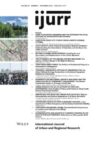Shifting scholarly gaze from India’s National Capital Region to Chennai’s newly expanded metropolitan peripheries, this article examines how the staggered production of relatively affordable single-family homes upon rural layouts both sustains and rearranges caste-land-based dominion in familiar yet crucially underexamined ways. We recall the framework of urban informality to unpack the politics and policies shaping Chennai’s spatial development, its agrarian land practices, and homeowning aspirations that invite low-income households, mortgage financers and outlaw builders to its peripheries. Our sociospatial–temporal inquiry is situated in a village we call Flux. As Flux’s landed class recalibrated farm/common lands for real estate, their maneuvers shared similarities with documented patterns of agrarian urbanism. But our focus on how long-held investor-plots change hands to produce homes, enables us to see that dominion rarely impairs newly endowed actors from recasting frontier spaces. We read emerging subaltern forms of market-rate affordable homes—built and owned primarily by non-dominant, intermediate caste groups—as the outcome of a developmentalist state that may have improved life chances for those in the ‘middle’. Yet the neoliberal dispensation that delivers affordable homes on unfinished layouts, recreates an unequal agrarian urban milieu and augurs least well for those who were and remain at the ‘bottom’ of agrarian society.
Details
Written by:
Ramya Ramanath, K.P. Manikandan
Digital Object Identifier (DOI)
https://doi.org/10.1111/1468-2427.70014
About DOI
